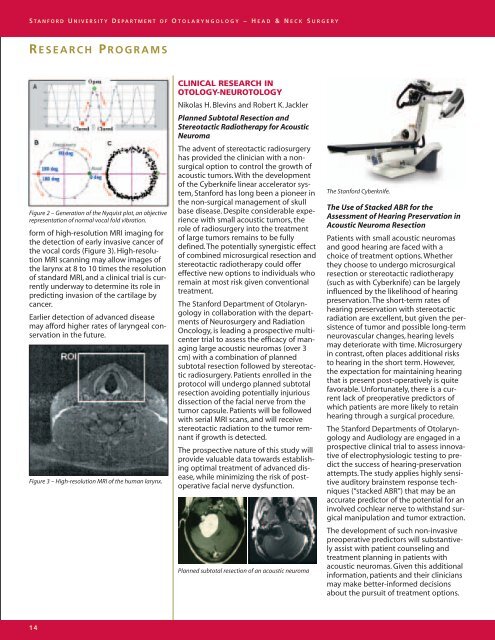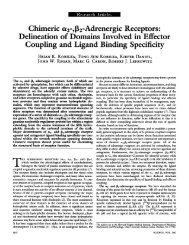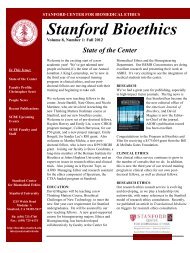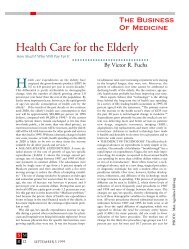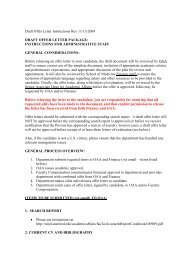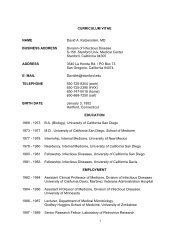HEAD & NECK SURGERY - Stanford University School of Medicine
HEAD & NECK SURGERY - Stanford University School of Medicine
HEAD & NECK SURGERY - Stanford University School of Medicine
You also want an ePaper? Increase the reach of your titles
YUMPU automatically turns print PDFs into web optimized ePapers that Google loves.
S T ANFORD U NIVERSITY D EPARTMENT OF O TOLARYNGOLOGY – <strong>HEAD</strong> & N ECK S URGERY<br />
R ESEARCH P ROGRAMS<br />
Figure 2 – Generation <strong>of</strong> the Nyquist plot, an objective<br />
representation <strong>of</strong> normal vocal fold vibration.<br />
form <strong>of</strong> high-resolution MRI imaging for<br />
the detection <strong>of</strong> early invasive cancer <strong>of</strong><br />
the vocal cords (Figure 3). High-resolution<br />
MRI scanning may allow images <strong>of</strong><br />
the larynx at 8 to 10 times the resolution<br />
<strong>of</strong> standard MRI, and a clinical trial is currently<br />
underway to determine its role in<br />
predicting invasion <strong>of</strong> the cartilage by<br />
cancer.<br />
Earlier detection <strong>of</strong> advanced disease<br />
may afford higher rates <strong>of</strong> laryngeal conservation<br />
in the future.<br />
Figure 3 – High-resolution MRI <strong>of</strong> the human larynx.<br />
14<br />
CLINICAL RESEARCH IN<br />
OTOLOGY-NEUROTOLOGY<br />
Nikolas H. Blevins and Robert K. Jackler<br />
Planned Subtotal Resection and<br />
Stereotactic Radiotherapy for Acoustic<br />
Neuroma<br />
The advent <strong>of</strong> stereotactic radiosurgery<br />
has provided the clinician with a nonsurgical<br />
option to control the growth <strong>of</strong><br />
acoustic tumors. With the development<br />
<strong>of</strong> the Cyberknife linear accelerator system,<br />
<strong>Stanford</strong> has long been a pioneer in<br />
the non-surgical management <strong>of</strong> skull<br />
base disease. Despite considerable experience<br />
with small acoustic tumors, the<br />
role <strong>of</strong> radiosurgery into the treatment<br />
<strong>of</strong> large tumors remains to be fully<br />
defined. The potentially synergistic effect<br />
<strong>of</strong> combined microsurgical resection and<br />
stereotactic radiotherapy could <strong>of</strong>fer<br />
effective new options to individuals who<br />
remain at most risk given conventional<br />
treatment.<br />
The <strong>Stanford</strong> Department <strong>of</strong> Otolaryngology<br />
in collaboration with the departments<br />
<strong>of</strong> Neurosurgery and Radiation<br />
Oncology, is leading a prospective multicenter<br />
trial to assess the efficacy <strong>of</strong> managing<br />
large acoustic neuromas (over 3<br />
cm) with a combination <strong>of</strong> planned<br />
subtotal resection followed by stereotactic<br />
radiosurgery. Patients enrolled in the<br />
protocol will undergo planned subtotal<br />
resection avoiding potentially injurious<br />
dissection <strong>of</strong> the facial nerve from the<br />
tumor capsule. Patients will be followed<br />
with serial MRI scans, and will receive<br />
stereotactic radiation to the tumor remnant<br />
if growth is detected.<br />
The prospective nature <strong>of</strong> this study will<br />
provide valuable data towards establishing<br />
optimal treatment <strong>of</strong> advanced disease,<br />
while minimizing the risk <strong>of</strong> postoperative<br />
facial nerve dysfunction.<br />
Planned subtotal resection <strong>of</strong> an acoustic neuroma<br />
The <strong>Stanford</strong> Cyberknife.<br />
The Use <strong>of</strong> Stacked ABR for the<br />
Assessment <strong>of</strong> Hearing Preservation in<br />
Acoustic Neuroma Resection<br />
Patients with small acoustic neuromas<br />
and good hearing are faced with a<br />
choice <strong>of</strong> treatment options. Whether<br />
they choose to undergo microsurgical<br />
resection or stereotactic radiotherapy<br />
(such as with Cyberknife) can be largely<br />
influenced by the likelihood <strong>of</strong> hearing<br />
preservation. The short-term rates <strong>of</strong><br />
hearing preservation with stereotactic<br />
radiation are excellent, but given the persistence<br />
<strong>of</strong> tumor and possible long-term<br />
neurovascular changes, hearing levels<br />
may deteriorate with time. Microsurgery<br />
in contrast, <strong>of</strong>ten places additional risks<br />
to hearing in the short term. However,<br />
the expectation for maintaining hearing<br />
that is present post-operatively is quite<br />
favorable. Unfortunately, there is a current<br />
lack <strong>of</strong> preoperative predictors <strong>of</strong><br />
which patients are more likely to retain<br />
hearing through a surgical procedure.<br />
The <strong>Stanford</strong> Departments <strong>of</strong> Otolaryngology<br />
and Audiology are engaged in a<br />
prospective clinical trial to assess innovative<br />
<strong>of</strong> electrophysiologic testing to predict<br />
the success <strong>of</strong> hearing-preservation<br />
attempts. The study applies highly sensitive<br />
auditory brainstem response techniques<br />
(“stacked ABR”) that may be an<br />
accurate predictor <strong>of</strong> the potential for an<br />
involved cochlear nerve to withstand surgical<br />
manipulation and tumor extraction.<br />
The development <strong>of</strong> such non-invasive<br />
preoperative predictors will substantively<br />
assist with patient counseling and<br />
treatment planning in patients with<br />
acoustic neuromas. Given this additional<br />
information, patients and their clinicians<br />
may make better-informed decisions<br />
about the pursuit <strong>of</strong> treatment options.


